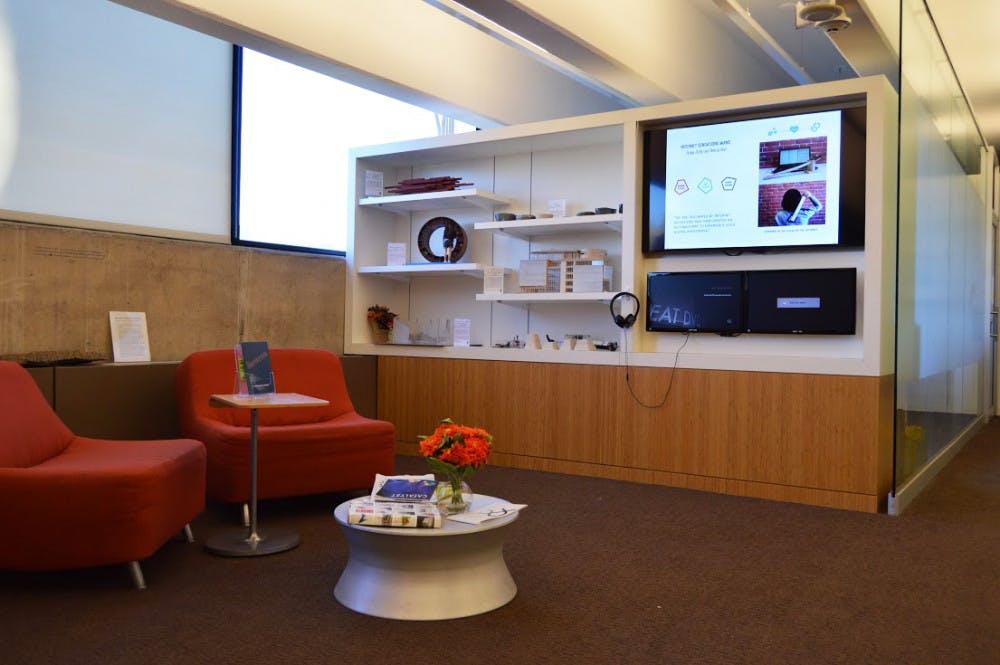Many students avoid exploring the contents of the Sciences Library’s 14 floors. Though the basement, lobby and mezzanine are well-charted territory, levels three through 14 are less loved and favored by students seeking isolation amongst the stacks. But for the past three years, the Science Center has increased the third floor’s appeal with the addition of a new student-based art installation each year, said Jodie Gill, Science Center program coordinator.
This year’s exhibit, “The Prototype,” officially opened Friday. The exhibit explores the design process behind everyday objects and was curated by Colvin Kenji Endo ’18, Teri Minogue ’18 and Adele Ruppert ’16. The project allows viewers to peek behind the scenes to “the inspiration, brainstorming, collaborations, revisions and dead ends” underneath everything from chairs and bowls to wearable guitars and “internet wands,” according to a pamphlet provided at the exhibit’s opening.
“The Prototype” features 12 pieces from 16 artists engaged in various design-based pursuits. “The design process is not limited to fine arts or graphic designers,” Minogue said. The team opened their call for submissions to any discipline in any medium on the Brown and Rhode Island School of Design campuses, ultimately displaying work from artists engaged in architecture, urban studies, engineering, visual arts and computer science.
To help cull the plethora of 3D-printed models, prototypes and digital renderings that were sent in, the team referred back to a squiggle that stood as the primary inspiration for the exhibit. This particular squiggle — vaguely resembling a hectic heartbeat gone flat — was drawn by designer and artist Damien Newman to represent the erratic design process.
It’s “what the design process should be,” Endo said. At first, “it’s this crazy mass of random thoughts starting at the stage of research, and then that narrows down, as you begin prototyping, and then, with clarity and focus, you have your final design. We want to show projects in all the different stages of the squiggle.”
The 12 pieces selected for “The Prototype” represent varied stages of completion. Symbolizing the beginning of the squiggle is “The Bathhouse,” by Andres Chang ’17 — a collection of beautifully illustrated maps, models and site plans for a suspended bathhouse.
Further along the squiggle lies Benjamin Basseches’ ’15 “Dynamic Seating,” which is in the prototype stage. The project includes a slanted wooden chair “that both encourage(s) movement and allows for a half-sitting, half-standing position,” according to the pamphlet, along with original sketches of the design.
Finally, the flat-lined end of the squiggle — the finished product — is represented by the “Bookwheel Social Center,” created by RISD alum Stan Lichens, resembling a large wooden wheel with bookshelves rimming the edges.
These works are intended to give the SciLi a much-needed “Granoff feel,” Gill said, referring to the creative arts center. Gill spearheaded the idea of using the space for exhibits four years ago so that SciLi frequenters can take a break from the stacks and immerse themselves in candy-colored panels and meticulously crafted sculptures.
“We didn’t want (the Science Center) to feel like the sterile environment that the library usually holds,” Gill said. “Now I think people are pleased when they see it and (don’t) just walk by to use the restroom,” Gill said.
Roughly 30 students and faculty members ventured up to the third floor Friday to view the art in celebration of the exhibit’s opening. Scattered within the crowd were the artists and administrators who helped make the exhibit happen.
“I think the intersection between science and design is great,” said Jokichi Matsubara ’18.
The exhibit will remain in the Science Center for the remainder of the academic year. And for those generally not drawn to art installations, the Science Center’s exhibition may, at the very least, be a worthwhile study spot.
“It’s nice to have something visually appealing instead of just concrete and white drywall,” Gill said.





